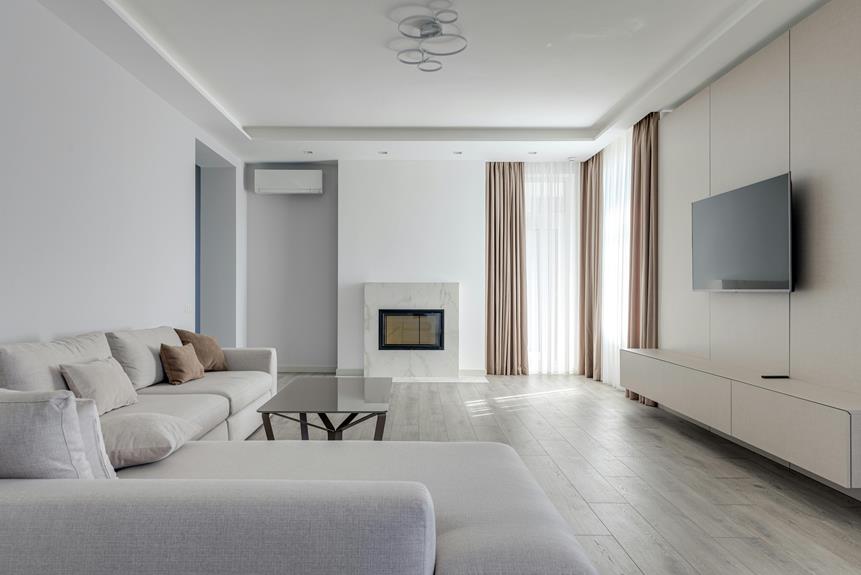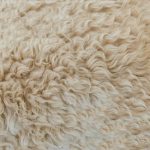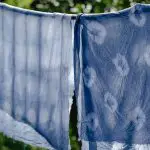When you're deciding between voile and linen, it's essential to consider what you value most in a fabric. Voile offers a light, airy touch that's great for creating delicate, summery styles, while linen boasts durability and breathability, making it a go-to for everyday wear. Each has its unique advantages and potential downsides, leaving you to ponder which one aligns better with your needs. So, which fabric truly stands out when it comes to versatility and longevity? Let's explore the intricacies of each to help you make an informed choice.
Table of Contents
Overview of Voile
Voile is a lightweight, semi-transparent fabric that you often find in curtains and summer garments, making it perfect for adding a delicate touch to any space or outfit. This airy textile is typically made from cotton or polyester, giving it a soft, smooth feel. Its sheer nature allows light to filter through gently, creating a warm and inviting atmosphere in your home.
When you're choosing voile for your projects, you'll appreciate its versatility. You can use it for everything from elegant drapery to flowy blouses. It's easy to work with, as it sews and drapes beautifully. Plus, voile comes in a variety of colors and patterns, allowing you to express your personal style easily.
One of the standout features of voile is its breathability, making it ideal for warm weather. You won't feel weighed down while wearing it, which is why many people love to incorporate it into their summer wardrobes. However, keep in mind that its delicate nature means it can snag or tear easily, so handling it with care is essential.
Overview of Linen
Linen is another popular fabric choice known for its strength and durability, making it a fantastic option for both clothing and home textiles. This natural fiber, derived from the flax plant, has been used for thousands of years, and its timeless appeal continues today.
You'll appreciate linen's breathability, which keeps you cool in warm weather, making it ideal for summer garments and lightweight bed linens.
One of the standout features of linen is its unique texture. It's slightly crisp and has a natural luster that adds elegance to any outfit or decor. Unlike synthetic fabrics, linen becomes softer with each wash, enhancing your comfort over time.
It also has excellent moisture-wicking properties, which can help keep you dry on hot days.
However, you should note that linen wrinkles easily, which some people find charming while others may see it as a drawback.
It's not just about aesthetics; linen is also highly absorbent and dries quickly, making it suitable for various uses.
Whether you're considering linen for fashion or home textiles, it's a versatile choice that stands the test of time.
Benefits of Voile
This lightweight fabric offers a delicate feel and a sheer appearance, making it perfect for creating airy curtains, flowing dresses, and elegant overlays. Voile stands out with its many benefits, adding charm and functionality to your projects.
- Breathability: Voile's light nature allows air to circulate easily, keeping you cool in warm weather.
- Versatility: This fabric can be used for various applications, from home décor to fashion, adapting smoothly to different styles.
- Easy Maintenance: Voile is generally machine washable and quick-drying, making it a practical choice for busy lifestyles.
Using voile can transform ordinary items into stunning pieces. Whether you're looking to enhance your wardrobe or spruce up your living space, this fabric's unique qualities make it a go-to option.
With its sheer beauty and functional benefits, you can't go wrong with choosing voile for your next project. Embrace the elegance and versatility of this delightful fabric and see how it can elevate your creations!
Benefits of Linen
When you choose linen, you're opting for unmatched breathability and comfort, perfect for warm weather.
Plus, linen is eco-friendly and sustainable, making it a great choice for environmentally conscious consumers.
Let's explore these benefits in more detail.
Breathability and Comfort
Known for its exceptional breathability, linen keeps you cool and comfortable even in the hottest weather. Its unique structure allows air to circulate freely, making it a perfect choice for summer clothing and bedding.
When you choose linen, you'll experience several key benefits:
- Moisture wicking: Linen absorbs moisture without feeling damp, so you stay dry and fresh.
- Temperature regulation: It adjusts to your body temperature, helping you stay warm in cooler months and cool when it's hot.
- Softness over time: The more you wash and wear linen, the softer and more comfortable it becomes, ensuring it feels great against your skin.
With its combination of breathability and comfort, linen is a standout fabric for any wardrobe. You'll appreciate how it keeps you feeling fresh and relaxed, whether you're lounging at home or enjoying a day out.
Investing in linen means investing in your comfort, making it a practical and stylish choice for your everyday needs.
Eco-Friendly and Sustainable
Linen stands out as an eco-friendly choice, thanks to its sustainable production process and minimal environmental impact. Made from the flax plant, linen requires far less water and pesticides compared to other fabrics. This means you're not only getting a beautiful textile but also supporting farming practices that are kinder to the planet.
When you choose linen, you're investing in a biodegradable material. Once it reaches the end of its life cycle, linen decomposes naturally, leaving no harmful residues behind. This is a stark contrast to synthetic fabrics, which can take centuries to break down.
Moreover, the durability of linen means it lasts longer, reducing the need for frequent replacements. You'll find that linen garments withstand wear and tear better than many other fabrics, making them a smart investment for your wardrobe.
Plus, the more you wash linen, the softer it becomes, enhancing its appeal over time.
Drawbacks of Each Fabric
When choosing between voile and linen, you should consider the drawbacks that come with each fabric.
Voile may lack the durability you want, while linen can be challenging to care for and maintain.
Additionally, both fabrics have their own trade-offs in terms of breathability and comfort that might affect your decision.
Durability and Longevity Issues
While both voile and linen offer unique aesthetic qualities, they each come with durability concerns that can affect their longevity in everyday use. Voile, known for its lightweight and sheer nature, is susceptible to tearing and fraying, especially in high-traffic areas. It's delicate, which means you should handle it with care to avoid damage.
On the other hand, while linen is generally stronger, it can still present some durability challenges.
Here are some key points to consider:
- Voile's Fragility: Its lightweight structure can lead to quick wear and tear.
- Linen's Wrinkling: Though it's robust, linen wrinkles easily, affecting its appearance over time.
- Color Fading: Both fabrics can fade with prolonged exposure to sunlight, diminishing their visual appeal.
Care and Maintenance Challenges
Caring for voile and linen presents its own set of challenges, as both fabrics require specific maintenance to preserve their beauty and functionality. Voile, while lightweight and delicate, can be prone to snagging and tearing. You'll need to handle it with care, avoiding rough surfaces and abrasive materials. Washing voile often demands a gentle cycle in cold water and air drying to prevent shrinking or losing its shape.
On the other hand, linen, although sturdy, wrinkles easily and can be tough to keep looking crisp. You may find yourself ironing it frequently to maintain its desired appearance. Linen also absorbs moisture, which means it can develop mildew if not dried properly. It's crucial to wash linen in lukewarm water and avoid harsh detergents that can degrade its fibers over time.
Both fabrics require your attention to detail in maintenance. If you neglect washing instructions or use the wrong drying methods, you might end up with fabric that doesn't look or feel its best.
Balancing care for these unique materials will ensure they remain a beautiful addition to your wardrobe or home.
Breathability and Comfort Trade-offs
Although both voile and linen offer breathability, they come with their own comfort trade-offs that can affect your overall experience.
Voile is lightweight and airy, making it perfect for warm weather. However, it can be slightly less durable and may not provide the same level of insulation on cooler days. You might find that while it feels soft against your skin, it can also be prone to wrinkles, which may detract from its polished look.
On the other hand, linen is known for its strength and unique texture. While it offers excellent moisture-wicking properties, it can feel a bit rough initially, especially if you're used to softer fabrics. Linen is also prone to creasing, which might require more frequent ironing if you prefer a tidy appearance.
Here are some key trade-offs to consider:
- Voile: Lightweight but less durable
- Voile: Soft feel but prone to wrinkles
- Linen: Strong and moisture-wicking but rougher texture
Ultimately, knowing these trade-offs will help you choose the fabric that best suits your comfort needs.
Choosing the Right Fabric
When selecting between voile and linen, consider your specific needs for comfort, breathability, and style.
Voile is lightweight and sheer, making it perfect for layering or creating a soft, airy look. If you're aiming for a romantic or ethereal vibe, voile's delicate nature will work wonders in your wardrobe or home decor.
On the other hand, linen is durable and has a more textured appearance. If you need something more robust and versatile, linen's natural fibers offer great breathability and moisture-wicking properties. This makes it an excellent choice for warm weather, whether you're wearing it as clothing or using it for curtains.
Think about how you plan to use the fabric. For casual, everyday wear, linen's sturdiness can be ideal. If you're looking for something more elegant for special occasions, voile might be the better option.
Consider the care requirements, too. Linen wrinkles easily but can be washed and worn effortlessly, while voile may require gentler handling to maintain its delicate structure.
Ultimately, the right fabric depends on your lifestyle and aesthetic preferences. Choose wisely, and you'll enjoy the benefits of your fabric choice for years to come.
Frequently Asked Questions
Can Voile and Linen Be Blended Together for Better Qualities?
Yes, you can blend voile and linen for improved qualities. This combination offers the softness and breathability of voile, along with the durability and texture of linen, creating a versatile fabric perfect for various applications.
How Do Maintenance Requirements Differ Between Voile and Linen?
When it comes to maintenance, you'll find that voile's lightweight fabric requires less ironing and can be machine washed, while linen often demands more care, needing gentle washing and frequent ironing to maintain its crisp appearance.
What Are the Environmental Impacts of Producing Voile and Linen?
When you consider the environmental impacts, you'll find that linen typically has a lower carbon footprint due to its natural growth process, while voile's impact can vary based on synthetic or blended materials used in production.
Are There Specific Uses for Voile and Linen in Fashion Design?
In fashion design, you'll find voile's lightweight, sheer quality perfect for layering and flowy garments, while linen's durability and breathability make it ideal for structured pieces and summer wear. Both fabrics offer unique aesthetic benefits.
How Do the Costs of Voile and Linen Compare in the Market?
When you compare costs, voile generally tends to be less expensive than linen. However, prices can vary based on quality and brand, so it's wise to shop around for the best deals before purchasing.
- Cotton Fabric With Soft Pile Like Chamois: a Detailed Look - June 22, 2025
- What Does Chamois Fabric Feel Like? A Texture Guide - June 22, 2025
- The Unique Qualities of Chamois Silk Fabric - June 22, 2025







